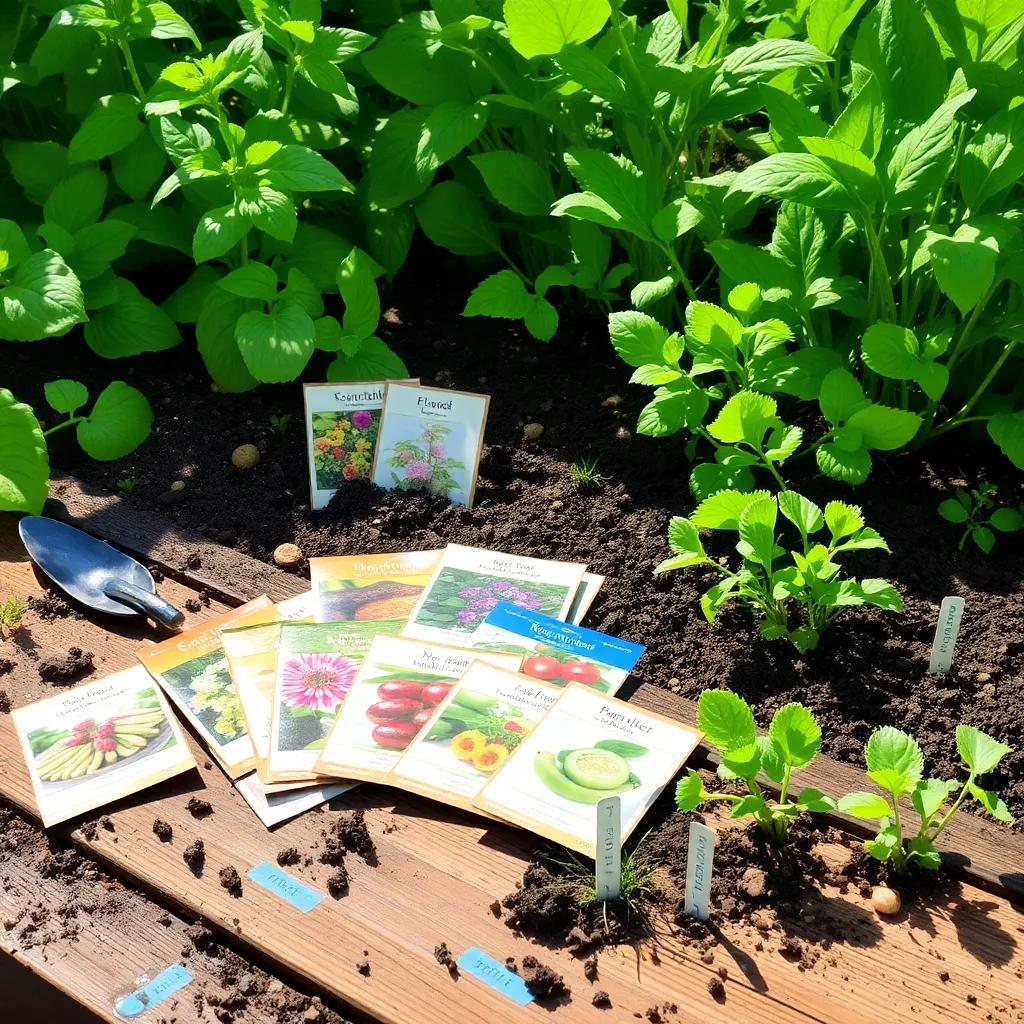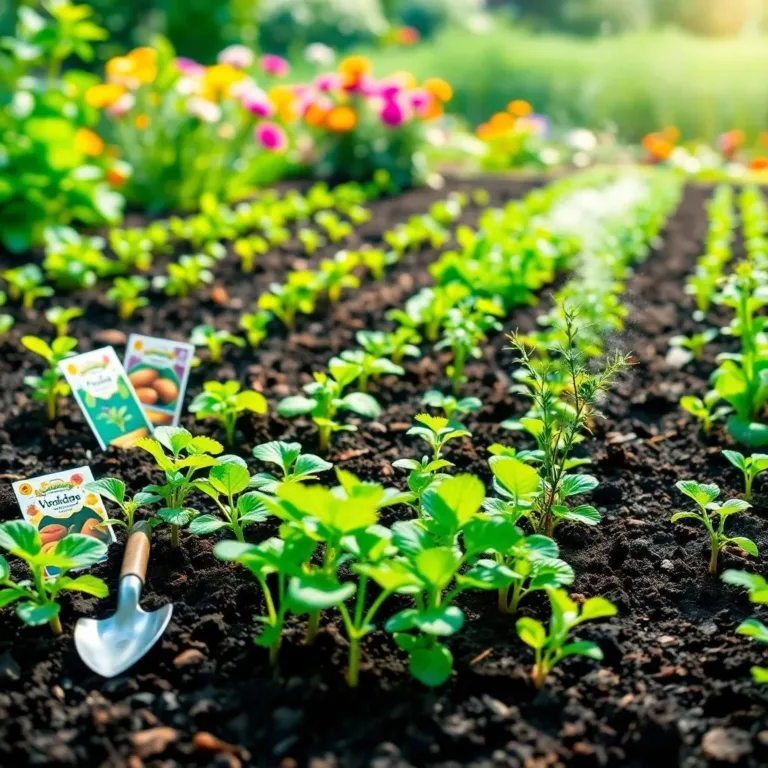Are you ready to watch your garden thrive? Planting seeds at the right depth can make all the difference between a lush green paradise and a patch of disappointment! Join me as we explore the secrets to successful seed planting, uncovering tips and tricks that will help your tiny seeds grow into amazing plants! Let’s dig in!
Factors Influencing Seed Planting Depth
When it comes to planting seeds, several factors play a significant role in how deep you should go. Let’s chat about these important points, so we can give our seeds the best start possible! After all, nobody wants to face the disappointment of watching a seed struggle to sprout. So, here’s what you need to keep in mind:
- Seed Size: This one’s pretty straightforward! Bigger seeds, like beans, usually need more room to grow. I often plant my larger seeds at a depth around 1 inch or so. On the flip side, smaller seeds, like those tiny lettuce seeds, should only be planted about 1/8 inch deep. They just don’t have the energy to push through too much soil!
- Soil Type: The kind of soil you have also affects planting depth. Sandy soils drain quickly, making it necessary to plant a bit deeper to get to that moisture below. However, if your garden is filled with clay, be careful! Planting too deep could lead to soggy seeds that just can’t sprout.
- Moisture Conditions: Keeping an eye on moisture levels is essential! If the soil is moist, be cautious not to bury the seeds too deep. Just think—too much moisture can lead to rotting! On the other hand, if it’s dry, planting too shallow might leave your precious seeds high and dry.
- Light Requirements: Some seeds love the sun, while others prefer some shade. Learning about your seeds’ light needs can help you decide how deep to plant them. For instance, seeds that love light should be close to the soil surface, while shade-loving seeds can dig a little deeper.
- Climate and Weather Conditions: Finally, we have climate! If you live in a rainy area, don’t plant too shallow. You could lose your seeds to heavy rain! If it’s hot and dry, planting too deep might hinder their growth. Be smart about where you live!
By factoring in these points, I’m sure you’ll have a successful planting experience! Let’s keep those seeds happy, healthy, and ready to grow!
Optimal Depths for Vegetable, Flower, and Herb Seeds
Now that we understand what influences seed planting depth, let’s dive into the optimal depths for various types of seeds. Getting this just right can make all the difference in how well our plants grow! Here’s a fun breakdown:
Vegetable Seeds
- Lettuce & Radishes: About 1/8 inch deep for those tiny guys! They love the light.
- Carrots & Beets: A bit deeper at around 1/4 inch.
- Beans & Peas: These larger seeds can go in about 1 inch deep. They love to stretch their roots!
Flower Seeds
- Small Flower Seeds: Think marigolds or petunias, which can be planted about 1/8 to 1/4 inch deep.
- Medium Seeds: For zinnias and sunflowers, aim for 1/2 inch to 1 inch.
- Large Seeds: Nasturtiums can reach depths of 1 inch. They’re like the bigger kids on the block!
Herb Seeds
- Tiny Herbs: Basil and parsley should be about 1/8 to 1/4 inch deep.
- Medium-Sized Herbs: Dill and cilantro can go 1/4 to 1/2 inch deep.
- Larger Herbs: For oregano and sage, aim for 1/2 to 1 inch deep.
Remember, these are just general guidelines! Always check your seed packets for the most accurate info. And hey, if you feel like getting a bit wild, soaking some seeds before planting can boost germination. It’s like giving them a little spa day!
So, armed with this information, let’s get planting! Watching our seeds transform into vibrant plants is truly a joy that never gets old. Happy gardening!

Correcting Common Planting Depth Mistakes
Mistakes happen, even to the best of us! When it comes to planting seeds, things can go a bit wrong. No worries though! If you find your seeds are planted too shallow or too deep, I’ve got some simple tips to help you fix those mistakes in no time!
If Your Seeds Are Planted Too Shallow:
- Cover Them Up: Gently sprinkle a light layer of soil over the seeds. Don’t go crazy—just a little will do! I like using my hands or a small garden tool for this.
- Mist with Water: Use a spray bottle to lightly mist the area. This helps settle the soil over the seeds. But remember, no heavy watering! We don’t want to displace them or turn the soil into mud.
- Monitor and Adjust: Keep an eye on your seeds. If you notice they’re still too exposed, you can add more soil or mulch carefully. Consistent moisture is key!
If Your Seeds Are Planted Too Deep:
- Re-Plant: Gently dig up the area where the seeds are buried. Be careful not to disturb any nearby seeds or little seedlings that may be sprouting.
- Adjust the Depth: Check the recommended depth for your seeds and replant them accordingly. Lightly press the soil around them to make sure they’re snug and ready to grow.
- Provide Care: Once you’ve corrected their depth, water them gently. Keeping the soil moist without flooding is the way to go!
By correcting these mistakes promptly, you’re giving your seeds the best chance to thrive. Remember, gardening is all about learning and having fun. So, don’t stress too much—just roll with it!
Consequences of Incorrect Planting Depth
Planting seeds at the right depth is one of those things that might seem small, but trust me, it matters! If seeds aren’t planted correctly, there can be some not-so-fun consequences that may leave your garden looking sad. Let’s chat about what might happen if things go wrong!
If Seeds Are Planted Too Deep:
- Poor Germination: Seeds buried too deep might struggle to find moisture and oxygen. They could take ages to sprout, or worse, not sprout at all! It’s like trying to swim when you’re stuck under a pile of blankets!
- Weak Seedlings: Even if they do manage to poke through the soil, those seedlings will often be weak. Picture a baby bird trying to fly with one wing tied down—it just doesn’t work!
- Delayed Growth: It might take longer for seedlings to emerge, leading to uneven growth. I like to see all my plants thriving together, so this can be frustrating!
If Seeds Are Planted Too Shallow:
- Desiccation: Seeds planted too shallow are at risk of drying out quickly. Wind and sun can suck away all the moisture they need!
- Poor Root Development: If seeds don’t have enough soil above them, their roots might not grow deep enough. Think of a plant trying to live in a tiny pot. It’s just not happy!
- Increased Vulnerability: Shallow seeds are also more likely to get eaten by pests or washed away in heavy rain. Yikes!
So, keeping planting depth in check is key to happy, healthy plants. I promise, paying attention to this will save you a lot of headaches later!
Tips for Successful Seed Germination and Growth
Now, let’s wrap it up with some tips that will help your seeds germinate successfully and grow like champions! After all, I want your garden to be bursting with life and color! Here’s what I’ve learned over the years:
- Read the Seed Packet: Start by reading the seed packet instructions. Each type of seed has specific needs, and that’s super important to know!
- Prepare the Soil: Take some time to prep your soil. Remove weeds and rocks, then mix in some compost. Healthy soil is like a cozy blanket for your seeds!
- Water the Soil: Moisten the soil before you plant. It should feel crumbly, not soggy. You want your seeds to start off right!
- Sow Seeds Evenly: When planting, make sure to spread the seeds evenly. This prevents crowding—no one likes a packed party!
- Label Your Seeds: Keep track of what you’ve planted by labeling! A little marker can go a long way in keeping things organized.
- Protect from Pests: If you notice critters sneaking around, use barriers like row covers to keep them at bay. We want your seeds to grow in peace!
- Monitor Moisture Levels: Check the soil moisture regularly. A good rule is to keep it moist but not soggy, kind of like a sponge!
- Thin Out Seedlings: As seedlings grow, make sure to thin them out to avoid overcrowding. This helps each plant get the space and nutrients it needs!
By following these tips, I know you’ll be on your way to a thriving garden! Remember, gardening is also about enjoying the journey. Happy planting!

